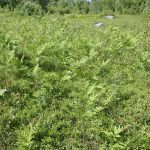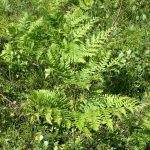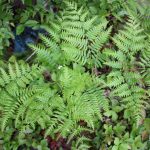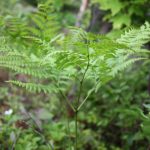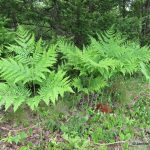Bracken fern
Prepared by Jennifer L. D’Appollonio, Assistant Scientist, University of Maine, Orono, ME 04469. March 2011.
Scientific name: Pteridium aquilinum (L.) Kuhn
Common name(s): Bracken fern, brackenfern, western brackenfern, bracken, western bracken, common bracken
Links: USDA PLANTS Profile, NPIN Profile, Go Botany
Images: (to see enlargements [PC]: click on image, then right click and choose “view image”)
- full sun
- June
- wooded edge of blueberry field
- fronds usually divided into 3 parts
Description:
– perennial
-family Pteridaceae
-deciduous fern
-can reach up to 2 m in height
-stout, cylindrical petioles up to 1 m long
-fifth most distributed common weed species of the world
-Reproduces by spores and creeping rhizomes (some up to 18′ long)
-Rigid leaf stalk 1′-3′ long, and swollen at base
-leaves are
- blades 2′-4′ long and 1′-3′ wide
- triangular to oval shaped
- with or without hairs on the underside
- spores in light brown masses on the underside of the leaf blade.
-The sporangia ripen from July to September
-noxious weed
-contains different poisonous agents: some cyanogen glycosides and factors of carcinogenic activity
– two subspecies in New England, ssp. latiusculum and ssp. pseudocaudatum; see Flora Novae Angliae information at bottom of Go Botany webpage
Habitat:
-grows and spreads successfully on many types of soils
-open woods
-pine forests
-silicate substrates
Source(s):
Haines, A., Farnsworth, E., Morrison, G., & New England Wild Flower Society. (2011). New England Wildflower Society’s Flora Novae Angliae: A manual for the identification of native and naturalized higher vascular plants of New England. Framingham, MA: New England Wild Flower Society. p. 54.
Vetter, J. (2009). A biological hazard of our age: Bracken fern [pteridium aquilinum (L.) kuhn]–a review. Acta Veterinaria Hungarica (Budapest. 1983), 57(1), 183-196. doi:10.1556/AVet.57.2009.1.18
Alonso-Amelot, M. E., & Rodulfo-Baechler, S. (1996). Comparative spatial distribution, size, biomass and growth rate of two varieties of bracken fern (pteridium aquilinum L. kuhn) in a neotropical montane habitat. Vegetatio, 125(2), 137-147. doi:10.1007/BF00044647

